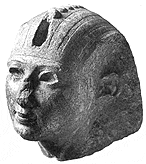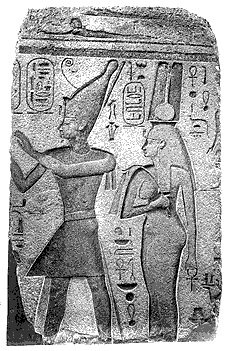|
|
 |
 |
|
|
 |
 |

Thought to have been a young man when he came to the throne (just by the fact that he reigned for over 40 years), Osorkon II was the son of Takelot I and his queen Kapes. It was long before Osorkon replaced Smendes III as High Priest of Amun with his cousin - Harsiese (this is seen as rather strange, breaking the tradition of the 22nd dynasty of placing either a brother or son in this position of power). Harsiese was a powerful figure, if his father Shoshenq II had lived then Harsiese himself would have been pharaoh rather than Osorkon II. Just 10 years or so into the reign of Osorkon II, Harsiese the High Priest recalled the days of the 21st Dynasty and Pinudjem I by claiming the full titles of a pharaoh.
Elsewhere in Egypt the standard procedure was adheared to - at Memphis the High Priest was replaced by Shoshenq D (heir to the throne) - son of Osorkon II and Queen Karomat B. A younger son, Harnakhte, was made High Priest of the cult of Amun at Tanis although this was purely a title without any resposnibilty - Prince Harnakhte died while still only 8 or 9 and was buried within Osorkon II's complex at Tanis. A third son, Nimlot C, was High Priest of Arsaphes in Heracleopolis (and later succeeded Harsiese's son at Thebes after Harsiese's death).
Building works of Osorkon II
Osorkon extended the features of the temple of Amun at Tanis (begun orignally by Psusennes I and Siamun), most of the stonework re-used from earlier features at Piramesse. Major additions were made to the temple of Bast at Bubastis (again using previous construction material originally used by Ramesses II)

The Royal Family
The Chief wife was the Queen and Royal Daughter Karoama B who gave Osorkon II at least two sons (Sheshonq D (heir to the throne), and Harnakht), and also three daughters ( Tasha-kheper, Karoama and [Ta?]-iir-mer. A third son is also sometimes mentioned - Takeloth (mother unknown), a fourth son, Nimlot C (High priest in Heracleopolis and also for a while in Thebes) whose mother was the lady Djedmutesankh. The lady Istemkheb G had a daughter Tjestbastperu A (there is a chance that this daughter could have married Takeloth, son of Sheshonq D, who succeeded as High Priest in Memphis).
In Year 23, the heir to the throne Sheshonq D buried an Apis Bull at Saqqara, but within a few years of this Sheshonq D died and was buried within the temple of Ptah at Memphis (Sheshonq D was followed by his son Takelot B as High Priest at Memphis).
Foreign policies
Osorkon II had very little or no ambition outside Egypt, the only case of an Egyptian army leaving Egypt was to join the coalition of Syro-Palestinian polities that opposed the Assyrian King Shalmaneser III. Towards the end of his reign Osorkon II limited himself to sending gifts (the Assyrians saw this as tribute) from Egypt to Assyria.
The end of the reign
Details from the end of Osorkon's reign (indeed the last fifteen years) are lacking, his last two years did see Thebes making another attempt for independence (under the leadership of Takelot II) which effectively left Egypt once more with two pharaohs ( after his death Osorkon II was followed by Sheshonq III - another possible son althought any evidence of a family relantionship is shadowy).
When he died Osorkon II was buried within his tomb at Tanis, re-using a sarcophagus dating from the Ramesside period. His tomb was robbed in antiquity leaving very few remains.

